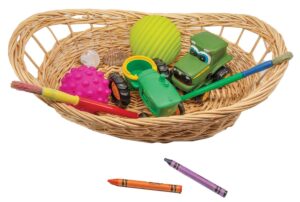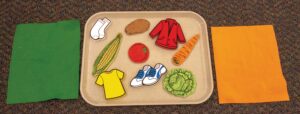Object inquiry skills
Toddlers identify objects that are the same and different.



Be Prepared: Secure sets of two materials that match by type (not color), such as two crayons, two pig figures, two paintbrushes. See a list of possibilities below. Use toddlers’ interests to identify objects. Place in each basket 4–5 sets of two matching items (total of 8–10 items per basket). Note the activity description suggests inviting 3–4 toddlers at a time to participate.
 Invite 3–4 toddlers to sort things we use in our room. Gather at a low table or sit with the toddlers on the floor. Give each toddler a basket of items and encourage toddlers to put together things that are the same in their basket. Encourage toddlers to put items that are the same on the table or floor, next to their basket. It is not necessary for toddlers to take turns.
Invite 3–4 toddlers to sort things we use in our room. Gather at a low table or sit with the toddlers on the floor. Give each toddler a basket of items and encourage toddlers to put together things that are the same in their basket. Encourage toddlers to put items that are the same on the table or floor, next to their basket. It is not necessary for toddlers to take turns.
Talk with toddlers about how things are the same and different. Emphasize observable details. Examples: “The tractor has no top or window.” “The back wheels of this tractor are big. Can you find one more tractor in your basket?” Identify the names of items as part of your descriptions and conversations. Encourage toddlers to talk about some feature of an item and avoid an emphasis on asking the name of a toy. Pause in your talk frequently so toddlers have an opportunity to contribute to conversations.
If time and toddler interest permit, invite toddlers to return all items to their baskets and swap baskets with a toddler in the gathering.

The activity helps toddlers focus on visual discrimination and think about how things are used. Matching by color is not a goal. If a toddler puts together two items that have the same color, such as a red crayon and a red ball, positively acknowledge the color match. Then point to one of the items, such as the ball, and encourage the toddler to find another ball.
Toddlers may dump the contents of their basket and begin playing with them right away. In a conversational way, begin talking with one toddler about what he/she found in the basket and point to how some items are the same. Respect each toddler’s approach to finding items that are the same.
A toddler may take an object from his/her basket and give it to you. Help the toddler look closely at the item by pointing to and talking about a key feature. Example: “Thank you, Simon. The toy you gave me has wheels in the front and back. Is there another toy like this in your basket?” Pause for the toddler to respond.
If a toddler shows little interest in the activity, make a note to draw attention to objects that are the same and different during play periods with balls, cars and trucks, or dramatic play materials. Present the activity again, using materials that are of special interest to a toddler. Some children may be very interested in matching little cars and trucks, whereas others will enjoy matching balls of the same size.
Extra support
Enrichment
Object inquiry skills, Problem-solving
A toddler sorts a collection of puzzle pieces into two groups.



Be Prepared: Select two simple puzzles focused on different themes, such as pets and vehicles or clothes and food. Use puzzles that are easy for toddlers to manipulate, such as chunky puzzles or puzzle pieces with knobs. Use your knowledge of a toddler’s interests to determine your choices. Remove all pieces from the two puzzles and place them in random order on the tray. Use no more than 4–5 pieces from each puzzle. Put the puzzle forms to the side; they are not used in this activity. Secure two felt pieces in contrasting colors and approximately 9 x 12 inches in size. Place the felt pieces next to the tray.
[Invite one toddler to join you on the floor or at a low table to help you fix a problem. Place the tray of puzzle pieces in front of the toddler. Sit facing the toddler.]
Two puzzles are mixed up! Some of the puzzle pieces are (one puzzle theme). Some of the puzzle pieces are (other puzzle theme).
Will you help me look at the puzzle pieces on our tray and find pieces that go together?
[Pause for the toddler’s response. Describe how two items are similar if it appears that the toddler is uncertain about the concept of go together. Example: Point to a banana puzzle piece and then to an apple puzzle piece. Explain these go together because they are things to eat.
Point to the two felt pieces when you describe each. Example: “We can put things we wear on this felt piece. We can put things we eat on this puzzle piece.”]
[Encourage the toddler to take one puzzle piece from the tray and say its name. Promptly say the name if the toddler seems uncertain. Then ask the toddler which group the selected piece goes in. Example: “This puzzle piece is an apple. Is an apple something we eat, or is an apple something we wear?”
Next, remind the toddler of the felt piece to be used for the type of item he/she selected. Encourage the toddler to put the puzzle piece on the designated felt piece.

Continue this procedure with each remaining piece on the tray.]
You are making two groups of things that go together. One group is for animals, and the other group is things that go.
The pieces of two puzzles were mixed up. You put pieces that go together on our different felt pieces.
[Invite the toddler to describe each group. Example: Why do these puzzle pieces go together?]
Pay close attention to a toddler’s initial response to the activity and quickly change a puzzle if it appears the theme is not of interest to the toddler.
Notice whether a toddler looks at the two groups of puzzle pictures on the felt pieces as part of considering where to put a puzzle picture. If the toddler is not looking at the groups, describe why a group of pictures go together as suggested in an Extra Support tip. If a toddler places a puzzle piece in an inappropriate group, you may wish to say nothing at the time of placement but later review each piece in a group and talk about how/whether it fits with the others. This may lead a toddler to correct his/her initial placement. Assure a toddler that it is okay to change his/her idea.
If a toddler shows little interest in sorting the puzzle pictures into two groups, modify the activity to fit his/her interest. A toddler may want to talk about puzzle pieces or point to pieces you name or line up all the pieces.
Extra support
Enrichment
Materials Needed: toy vehicles representing 2–3 different colors, play dishes representing 2–3 different colors, green paper circles and squares, 2 baskets
Provide opportunities for toddlers to pay attention to and potentially sort items by color. Arrange the toy vehicles on a low surface in random order and invite toddlers to put together vehicles of the same color. Add challenge by encouraging toddlers to make a set of two vehicles that are different colors, such as a blue car and a red car. Set the table in dramatic play with dishes in random order that can be organized by color.
Cut circles and squares from green paper, or a color of your choice, that toddlers can sort into one of two baskets. As a follow-up activity, consider promoting creative work with the shapes by providing card stock, glue, and an invitation to affix the shapes on a sheet of card stock any way a toddler wishes.
Materials Needed: small toys such as animal figures and vehicles, 2–3 baskets, large buttons or beads, tray, Go Fish card game
In addition to offering Options 1 and 2, small toys (such as animal figures and vehicles), can be placed randomly in baskets for toddlers to sort and match. Preschool-age children will enjoy sorting and matching large buttons or beads by placing them in a tray. The activity should be offered away from infants and toddlers. Preschool-age and older children will enjoy a game of Lotto or identifying identical cards in a Go Fish deck.